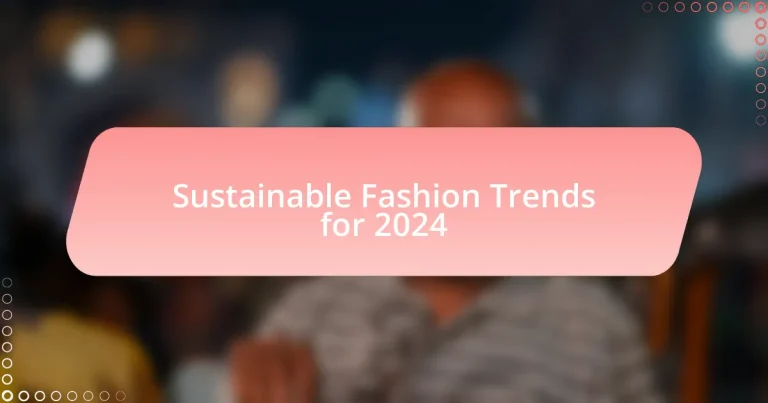The article focuses on the key sustainable fashion trends for 2024, highlighting circular fashion, the use of biodegradable materials, and transparency in supply chains. It examines how consumer preferences are shaping these trends, with a significant emphasis on environmental sustainability, ethical labor practices, and brand accountability. The role of technology in enhancing sustainability through innovative materials and supply chain transparency is also discussed. Additionally, the article outlines the principles of circular fashion, emerging materials, and the challenges brands face in sourcing recycled materials, while providing practical tips for consumers to support sustainable practices.

What are the key Sustainable Fashion Trends for 2024?
The key sustainable fashion trends for 2024 include circular fashion, increased use of biodegradable materials, and a focus on transparency in supply chains. Circular fashion emphasizes the reuse and recycling of garments to minimize waste, with brands like Patagonia leading the way by offering repair services and recycling programs. The use of biodegradable materials, such as organic cotton and Tencel, is gaining traction as consumers demand eco-friendly options; for instance, brands like Stella McCartney are pioneering this shift. Transparency in supply chains is becoming essential, with companies like Everlane showcasing their production processes to build consumer trust and accountability. These trends reflect a growing commitment to sustainability within the fashion industry, driven by consumer awareness and regulatory pressures.
How are consumer preferences shaping these trends?
Consumer preferences are significantly shaping sustainable fashion trends for 2024 by driving demand for eco-friendly materials and ethical production practices. As consumers increasingly prioritize sustainability, brands are responding by adopting practices such as using organic fabrics, reducing waste, and ensuring fair labor conditions. For instance, a survey by McKinsey & Company found that 67% of consumers consider the use of sustainable materials important when making fashion purchases, indicating a clear shift towards environmentally conscious buying behavior. This consumer-driven demand is prompting brands to innovate and align their offerings with sustainability goals, thereby influencing the overall direction of the fashion industry.
What specific values are consumers prioritizing in sustainable fashion?
Consumers are prioritizing values such as environmental sustainability, ethical labor practices, and transparency in sourcing within sustainable fashion. Research indicates that 66% of global consumers are willing to pay more for sustainable brands, highlighting the importance of eco-friendly materials and production processes. Additionally, a survey by McKinsey & Company found that 67% of consumers consider brand transparency regarding supply chains as a critical factor in their purchasing decisions. These values reflect a growing demand for accountability and responsibility in the fashion industry.
How do these preferences influence brand strategies?
Consumer preferences for sustainability significantly influence brand strategies in the fashion industry. Brands are increasingly adopting eco-friendly materials, ethical production practices, and transparent supply chains to align with the growing demand for sustainable products. For instance, a 2022 survey by McKinsey & Company found that 67% of consumers consider sustainability when making a purchase, prompting brands to integrate sustainability into their core values and marketing strategies. This shift not only enhances brand loyalty but also attracts a broader customer base that prioritizes environmental responsibility.
What role does technology play in sustainable fashion for 2024?
Technology plays a crucial role in sustainable fashion for 2024 by enabling innovative materials, enhancing supply chain transparency, and promoting circular economy practices. Advanced technologies such as artificial intelligence and blockchain facilitate the tracking of materials from production to consumer, ensuring ethical sourcing and reducing waste. For instance, AI-driven design tools can optimize fabric usage, minimizing excess and promoting resource efficiency. Additionally, innovations like 3D printing allow for on-demand production, significantly reducing overproduction and inventory waste. These technological advancements collectively contribute to a more sustainable fashion industry by lowering environmental impact and fostering responsible consumption.
How are innovations in materials contributing to sustainability?
Innovations in materials are significantly contributing to sustainability by enabling the development of eco-friendly textiles that reduce environmental impact. For instance, the use of organic cotton, recycled polyester, and biodegradable fabrics minimizes resource consumption and waste generation. According to a report by the Textile Exchange, the global market for sustainable textiles is projected to reach $8.25 billion by 2025, highlighting the increasing demand for materials that support sustainable practices. Additionally, advancements in fabric technology, such as waterless dyeing processes and the creation of materials from agricultural waste, further enhance sustainability by lowering water usage and carbon emissions in production.
What technologies are brands using to enhance transparency?
Brands are using blockchain technology, RFID tags, and digital platforms to enhance transparency in their supply chains. Blockchain provides an immutable ledger that allows consumers to trace the origin of materials and verify ethical practices, as seen in initiatives like Provenance and Everledger. RFID tags enable real-time tracking of products, ensuring authenticity and reducing counterfeiting, which is crucial for brands like Zara and H&M. Additionally, digital platforms such as apps and websites allow brands to share detailed information about their sourcing, production processes, and sustainability efforts, fostering consumer trust and accountability.
Why is circular fashion gaining traction in 2024?
Circular fashion is gaining traction in 2024 due to increasing consumer awareness of environmental issues and the demand for sustainable practices in the fashion industry. This shift is evidenced by a 2023 survey indicating that 70% of consumers prioritize brands that adopt eco-friendly practices, reflecting a growing preference for products that minimize waste and promote recycling. Additionally, regulatory pressures are mounting, with governments worldwide implementing stricter guidelines on waste management and sustainability, further encouraging brands to adopt circular models. The combination of consumer demand and regulatory support is driving the momentum for circular fashion in 2024.
What are the principles of circular fashion?
The principles of circular fashion include designing for longevity, promoting resource efficiency, and encouraging recycling and upcycling. Designing for longevity ensures that garments are made to last, reducing the frequency of disposal. Resource efficiency focuses on minimizing waste and using sustainable materials throughout the production process. Encouraging recycling and upcycling involves creating systems that allow for the recovery of materials from used clothing, thereby reducing the need for new resources. These principles collectively aim to create a closed-loop system in the fashion industry, significantly reducing environmental impact and promoting sustainability.
How can brands implement circular practices effectively?
Brands can implement circular practices effectively by adopting strategies such as designing for longevity, utilizing sustainable materials, and establishing take-back programs. Designing for longevity involves creating products that are durable and timeless, which reduces waste and encourages consumers to keep items longer. Utilizing sustainable materials, such as recycled fabrics or organic cotton, minimizes environmental impact and supports resource conservation. Establishing take-back programs allows brands to reclaim used products, facilitating recycling or refurbishment, which further reduces waste. According to a report by the Ellen MacArthur Foundation, transitioning to a circular economy could generate $4.5 trillion in economic benefits by 2030, highlighting the potential for brands to thrive while promoting sustainability.

What are the emerging materials in sustainable fashion for 2024?
Emerging materials in sustainable fashion for 2024 include mycelium leather, recycled ocean plastics, and bio-fabricated textiles. Mycelium leather, derived from fungi, offers a biodegradable alternative to traditional leather, reducing environmental impact. Recycled ocean plastics are being repurposed into fabrics, addressing marine pollution while creating durable clothing. Bio-fabricated textiles, such as those made from lab-grown fibers, provide innovative solutions that minimize resource use and waste. These materials reflect a growing trend towards eco-friendly practices in the fashion industry, aligning with consumer demand for sustainability.
How do these materials compare to traditional options?
Sustainable materials generally outperform traditional options in terms of environmental impact and resource efficiency. For instance, organic cotton uses 91% less water than conventional cotton, significantly reducing water scarcity issues. Additionally, recycled polyester diverts plastic waste from landfills and reduces energy consumption by up to 75% compared to virgin polyester production. These advantages highlight the growing preference for sustainable materials in the fashion industry, aligning with consumer demand for eco-friendly practices.
What are the environmental impacts of these new materials?
The environmental impacts of new materials in sustainable fashion include reduced resource consumption, lower carbon emissions, and decreased waste generation. For instance, materials like organic cotton and recycled polyester require significantly less water and energy compared to conventional fabrics, leading to a smaller ecological footprint. Research indicates that using recycled polyester can reduce energy consumption by up to 60% compared to virgin polyester production. Additionally, biodegradable materials, such as Tencel, break down more easily in the environment, minimizing landfill contributions. These advancements contribute to a more sustainable fashion industry by addressing critical environmental issues.
How do consumers perceive these materials?
Consumers perceive sustainable materials in fashion as increasingly valuable and essential for ethical consumption. A survey conducted by McKinsey & Company in 2022 revealed that 67% of consumers consider sustainability when making a purchase, indicating a strong preference for eco-friendly materials. Additionally, consumers associate these materials with higher quality and durability, as evidenced by a 2023 report from the Global Fashion Agenda, which states that 75% of consumers believe sustainable materials enhance the longevity of products. This perception drives demand for brands that prioritize sustainability, influencing purchasing decisions and brand loyalty.
What are the benefits of using recycled materials in fashion?
Using recycled materials in fashion significantly reduces environmental impact by minimizing waste and conserving resources. This practice decreases the demand for virgin materials, which often require extensive energy and water for production. For instance, using recycled polyester can save up to 75% of the energy needed to produce new polyester from petroleum. Additionally, recycling textiles can divert millions of tons of waste from landfills, contributing to a circular economy. The fashion industry, which is responsible for approximately 10% of global carbon emissions, can lower its carbon footprint through the adoption of recycled materials, thus promoting sustainability and addressing climate change.
How does recycling contribute to waste reduction?
Recycling significantly contributes to waste reduction by diverting materials from landfills and reprocessing them into new products. This process minimizes the volume of waste generated, as recycling can reduce the need for raw materials, thereby decreasing the overall waste footprint. For instance, the Environmental Protection Agency (EPA) reports that recycling and composting prevented the release of approximately 186 million metric tons of carbon dioxide equivalent into the air in 2018, highlighting the environmental benefits of recycling in waste management.
What challenges do brands face when sourcing recycled materials?
Brands face several challenges when sourcing recycled materials, including inconsistent quality, limited availability, and higher costs. Inconsistent quality arises because recycled materials can vary significantly in composition and performance, making it difficult for brands to maintain product standards. Limited availability is another issue, as the supply of recycled materials often does not meet the growing demand from brands committed to sustainability. Additionally, sourcing recycled materials can be more expensive due to the processing and logistics involved, which can deter brands from fully committing to sustainable practices. These challenges are compounded by the need for transparency in supply chains, as brands must ensure that their recycled materials are sourced ethically and sustainably.

How are brands promoting sustainable practices in 2024?
Brands are promoting sustainable practices in 2024 by implementing circular economy models, utilizing eco-friendly materials, and enhancing transparency in their supply chains. For instance, many fashion brands are adopting recycling programs that allow consumers to return used garments for repurposing, thereby reducing waste. Additionally, the use of organic cotton, recycled polyester, and innovative materials like Tencel has increased, reflecting a commitment to environmentally friendly production. Transparency is also a key focus, with brands providing detailed information about sourcing and manufacturing processes, which builds consumer trust and encourages responsible purchasing. According to a report by McKinsey & Company, 67% of consumers consider sustainability when making fashion purchases, indicating a significant shift towards eco-conscious consumer behavior.
What marketing strategies are effective for sustainable fashion brands?
Effective marketing strategies for sustainable fashion brands include transparency in sourcing, storytelling that highlights ethical practices, and leveraging social media for community engagement. Transparency builds trust, as consumers increasingly prefer brands that disclose their supply chain and production processes; for instance, a 2021 survey by McKinsey found that 67% of consumers consider sustainability when making a purchase. Storytelling allows brands to connect emotionally with consumers, showcasing the impact of their sustainable practices, which can enhance brand loyalty. Additionally, social media platforms enable brands to create interactive campaigns that foster community involvement and awareness, as evidenced by the success of campaigns like #WhoMadeMyClothes, which encourages consumers to inquire about the origins of their clothing.
How can storytelling enhance brand engagement?
Storytelling enhances brand engagement by creating emotional connections between consumers and brands. When brands share compelling narratives about their values, mission, and the impact of their products, they foster a sense of authenticity and relatability. For instance, a study by the Harvard Business Review found that emotionally connected customers are more than twice as valuable as highly satisfied customers, as they exhibit greater loyalty and advocacy. This connection is particularly vital in sustainable fashion, where consumers increasingly seek brands that align with their values and contribute positively to social and environmental issues. By effectively utilizing storytelling, brands can communicate their commitment to sustainability, thereby increasing consumer trust and engagement.
What role do social media platforms play in promoting sustainability?
Social media platforms play a crucial role in promoting sustainability by facilitating awareness, engagement, and community building around sustainable practices. These platforms enable brands and individuals to share information about eco-friendly products, sustainable fashion trends, and environmental issues, reaching a global audience. For instance, campaigns like #SustainableFashion have garnered millions of posts, encouraging consumers to make informed choices. Additionally, studies show that 79% of consumers are influenced by social media when making purchasing decisions, highlighting its impact on promoting sustainable brands and practices.
What partnerships are emerging in the sustainable fashion industry?
Emerging partnerships in the sustainable fashion industry include collaborations between established brands and innovative startups focused on eco-friendly materials and practices. For instance, major fashion brands like Stella McCartney are partnering with technology companies such as Bolt Threads to develop sustainable fabrics made from mycelium, a mushroom-based material. Additionally, brands like H&M are collaborating with organizations like the Ellen MacArthur Foundation to promote circular fashion initiatives, aiming to reduce waste and enhance recycling efforts. These partnerships are driven by a shared commitment to sustainability and are increasingly recognized as essential for addressing environmental challenges in the fashion sector.
How do collaborations between brands and NGOs benefit sustainability efforts?
Collaborations between brands and NGOs enhance sustainability efforts by leveraging the expertise and resources of both sectors to drive impactful environmental initiatives. Brands gain access to NGOs’ knowledge on sustainable practices, enabling them to implement more effective strategies in their operations. For instance, partnerships can lead to the development of eco-friendly materials or waste reduction programs, which are crucial in the fashion industry, known for its significant environmental footprint. A notable example is the collaboration between H&M and the NGO WWF, which focuses on sustainable cotton sourcing, resulting in a 50% increase in the use of organic cotton in their collections. Such partnerships not only improve brand reputation but also contribute to measurable sustainability outcomes, demonstrating the effectiveness of joint efforts in addressing environmental challenges.
What impact do industry coalitions have on sustainable practices?
Industry coalitions significantly enhance sustainable practices by fostering collaboration among businesses to share resources, knowledge, and best practices. These coalitions create a unified approach to sustainability, enabling members to set common goals, such as reducing carbon emissions or improving supply chain transparency. For instance, the Sustainable Apparel Coalition, which includes major brands like Nike and H&M, has developed the Higg Index, a standardized measurement tool that helps companies assess their environmental and social impacts. This collective effort not only accelerates the adoption of sustainable practices across the industry but also drives innovation and accountability, ultimately leading to more environmentally friendly operations.
What practical tips can consumers follow to support sustainable fashion in 2024?
Consumers can support sustainable fashion in 2024 by prioritizing second-hand shopping, which reduces waste and extends the lifecycle of clothing. Buying from thrift stores, online resale platforms, or clothing swaps minimizes the demand for new production, which is often resource-intensive. According to a report by the Ellen MacArthur Foundation, extending the life of garments by just nine months can reduce carbon, water, and waste footprints by 20-30%. Additionally, consumers should choose brands that prioritize ethical practices, such as transparent supply chains and sustainable materials, as these companies often have a lower environmental impact. Engaging in clothing care, such as proper washing and repairing, also contributes to sustainability by prolonging the life of garments.


